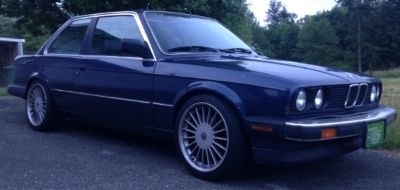Even just hand calcs breaking things down with a basic freebody diagram would cover the commentary...(FEA/FEM is overkill for this) there are aspects of this that look simpler to fabricate, but just stating without data that its better, and then only backing it up with an "I know better, of course it is" doesn't ring...
Bayside Fabrication S54 E30 Subframe Solution
Collapse
X
-
Even just hand calcs breaking things down with a basic freebody diagram would cover the commentary...(FEA/FEM is overkill for this) there are aspects of this that look simpler to fabricate, but just stating without data that its better, and then only backing it up with an "I know better, of course it is" doesn't ring...
2006 Subaru WRX
1987 E30 Royalblau Metallic S52 OBDii
1982 VW Westfalia 1.5d-gone -
IF
You put a shear plate in here that connected both ball joint bosses to both rack bosses...
AND
Made your lower rack mounts triangular so they have very wide bases to react transverse forces
THEN
I think your design would be much stiffer in reacting transverse forces from cornering loads.
Also, you have a lot of places where three beads meet where you're welding three pieces of metal together at a corner. This promotes stress fractures at the point where the beads meet. As a bead cools, it contracts and puts tensile stress into the metal next to it. When you join a second bead up to the end of a first bead, you increase that tensile stress at the point where the beads meet because the second bead pulls more on the surrounding metal where the first bead already pulled. Loads in a structure tend to produce the highest stresses at the corners. Joining the beads creates a small area of high stress and the fact that the loads naturally produce higher stresses at the corners of the structure combine to create the perfect circumstances for nucleating a crack.
True structural welding rarely joints beads.
ETA: I just noticed the HoHo in the background. Bump that transverse ball joint load up to 2000#...Last edited by The Dark Side of Will; 03-08-2019, 02:07 PM.Comment
-
The forces and moments can be resolved with a free body diagram, but the geometry of his metal looks fairly complex. I wouldn't want to try to figure out the stresses by hand.Even just hand calcs breaking things down with a basic freebody diagram would cover the commentary...(FEA/FEM is overkill for this) there are aspects of this that look simpler to fabricate, but just stating without data that its better, and then only backing it up with an "I know better, of course it is" doesn't ring...Comment
-
Yes but you could generalize a lot of this to get the idea of how it looks.
Yes the fore/aft suspension loads with the extra gusset tube are nice(But what, that just get dumped into the fire all.....) then the steering lateral loads get simplified into compression/tension over the cross tube and its offset connection to the old sub-frame. even starting at looking at it to this level would be reasonable.
edit:
I just don't like the blanket, of course its better, because "insert my opinion" it is argument. This could be looked at a lot of ways. I also get that this what we're doing, but we're just asking for proof of why its better, not just being told its better.Last edited by dynoclimb; 03-08-2019, 02:22 PM.
2006 Subaru WRX
1987 E30 Royalblau Metallic S52 OBDii
1982 VW Westfalia 1.5d-goneComment
-
For nearly two decades I’ve designed, detailed and signed off on multiple vehicle bodies, super structures and body mounted equipment all of which were highly optimised safety critical fabricated components operating in a dynamic environment. Accordingly I’ve had to meet strict design codes and requirements to achieve certification.
Typically this involves lots of verification and validation using hand calculations, FEA, static and dynamic strain gauge testing. These days i do lots of consulting work and regularly come across issues where designers haven’t though about load paths and have used exceptionally poor weld joint details. Things don’t usually snap in half due to overload except in collision scenarios they usually crack over time due to fatigue. In a dynamic environment any weakness in the design will always be found out its just a matter of how far down the line.
My comments were not because i am an asshole or picking on this design (others around are not really great either) it was free advice as i know when something doesn’t really look right. It’s always a good idea to draw free body diagrams, look at load paths and force flow to make them as continuous and direct as practical, minimise discontinues and minimise welding if you dont have access to fancy analysis tools.Last edited by digger; 03-08-2019, 03:11 PM.89 E30 325is Lachs Silber - currently M20B31, M20B33 in the works, stroked to the hilt...
new build thread http://www.r3vlimited.com/board/showthread.php?t=317505

Comment


Comment